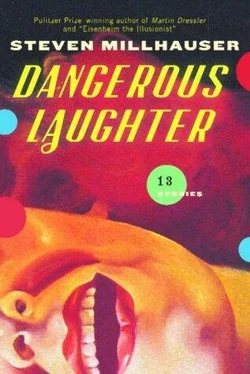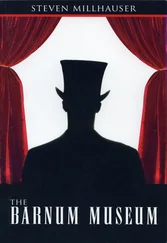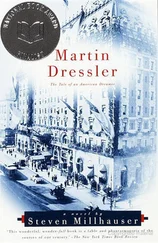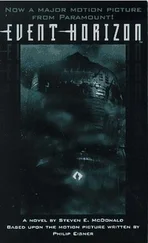And indeed there now began a period of excess, of overabundant fulfillment, as if the banishment of the face had removed some nuance of restraint still present in the earlier collections. Inspired by Hyperion, dresses became fevered with obscure cravings, with sudden illuminations and desolations, and threw themselves into hopeless adventures. Restless and dissatisfied, they grew in every direction; in some instances they exceeded the size of rooms and had to be worn in large outdoor spaces, like backyards or public parks. The vast lower depths of such dresses encouraged coarse speculation. It was said that beneath those coverings, naked women coupled madly with young lovers in the grass. One dress contained in its side a little red door, which was said to lead to a room with a bed, a mirror, and a shaded lamp. Another dress, designed for the wife of a software CEO, rose three stories high and was attached to the back of the house by a covered walkway. A celebrated fashion journalist with a fondness for historical parallels compared these developments to the fanatical elaborations of coiffure in the late eighteenth century, when three-foot castles of hair rose on wire supports. The new dresses were not so much worn as entered — it was as if they wished to carry the structural qualities of fashion to the point at which clothing began to merge with architecture.
Such excesses were not without a touch of desperation, as if the escape of costume from the female body had created in clothes an uncertainty, a sharp malaise. One summer afternoon during a party at an estate in northwestern Connecticut, an unusual immobility in the lavish dresses became apparent. Had the women taken a solemn vow not to move? The stationary costumes, arranged on a lawn that sloped down to a lake, resembled a form of sculpture. Four men, bored or excited by the motionless women, stood before one of them, talking and drinking hard. Suddenly two of the men bent over, grasped the heavy dress by the hem, and lifted it violently into the air. Voices shouted, cheered. Underneath they discovered only the lawn itself, stretching away.
The four men rushed over to the other dresses, yanking them up, knocking them over, tearing at them with their fingers, but the women had disappeared. Later that day they were discovered in the kitchen of a neighbor’s house, dressed in old bathrobes and talking among themselves.
For a time the new fashion caught on. Women donned immense dresses and then quietly withdrew, wandering away to do whatever they liked. Dresses, freed at last from bodies, became what they had always aspired to be: works of art, destined for museums and private collections. Often they stood on display in large living rooms, beside pianos or couches.
But the complete separation of clothing from women’s bodies created a new confusion. Women no longer knew how to dress, what to wear. Many dressed in a deliberately slatternly way, as if to express their sense of the unbearable distance between the perfection of high costume and the humiliating imperfection of the body it was meant to obliterate. It was as if a superior race of beings had been inserted into the world: the race of costume. A tension was building; there were rumors of an uprising of women, who would overthrow the dresses that had rendered them superfluous. Such talk, however absurd, revealed a longing for something new, for a redemptive leap. People spoke hungrily of new, impossible dresses — dresses worn on the inside of the body, dresses the size of entire towns. Others proposed an Edenic nakedness. As the new season approached, it was clear that something had to happen.
It was at this moment that Hyperion gave his only interview. In it he abjured the fashions that had made him famous; apologized to women for leading them astray; revealed that his name was Ben Hirschfeld, of Brooklyn; and announced his retirement after the coming show. The interview was analyzed relentlessly, attacked as a promotional stunt, dismissed as a hoax. On the nightly news a short, balding man stood under an umbrella as he blinked nervously behind small round lenses and said that yes, his name was Benjamin Hirschfeld, yes, he lived in Brooklyn, but no, he knew nothing about fashion, nothing about clothes, nothing. The public, skeptical and patient, waited.
And the moment came; it was not what anyone had expected. Along the catwalk strolled a tall model in a classic fitted dress, with a trim waist and a full, pleated skirt. Her face, entirely exposed, bore an indolent and haughty look that hadn’t been seen for years. The new, impoverished dress represented a repudiation of everything Hyperion had stood for. At the same time, within the culture of the liberated dress, it struck a radical note. Women hesitated; here and there, in a spirit of daring, someone appeared at a party dressed in the new style. One day, as if by secret agreement, the fashion was everywhere. The monstrous old dresses drifted into attics, where young girls, climbing the stairs in search of an abandoned dollhouse or a pair of skates, came upon something looming against the rafters and stopped uneasily before continuing on their way. At dinner parties and family gatherings, people recalled the old style with amusement and affectionate embarrassment, as one might remember an episode of drunkenness. In memory the dresses became more vivid, more remote, until they seemed like brilliant birds rising in dark forests or like distant sunlit towns. Meanwhile the new dresses grew a little shorter, a little longer; slacks and blouses grew tighter, looser. One afternoon in late summer, on a sidewalk printed with the shade of maple leaves and flickers of sun, a woman walking with her young daughter had the sense that she was about to remember something, something about a dress, but no, it was gone, vanished among the overhead leaves already turning, the bits of blue sky, the smell of cut grass, the chimney shadows sharp and black on the sunlit roofs.
A PRECURSOR OF THE CINEMA
EVERY GREAT INVENTIONis preceded by a rich history of error. Those false paths, wrong turns, and dead ends, those branchings and veerings, those wild swerves and delirious wanderings — how can they fail to entice the attention of the historian, who sees in error itself a promise of revelation? We need a taxonomy of the precursor, an aesthetics of the not-quite-yet. Before the cinema, that inevitable invention of the mid-1890s, the nineteenth century gave birth to a host of brilliant toys, spectacles, and entertainments, all of which produced vivid and startling illusions of motion. It’s a seductive prehistory, which divides into two lines of descent. The true line is said to be the series of rapidly presented sequential drawings that create an illusion of motion based on the optical phenomenon known as persistence of vision (Plateau’s Phenakistoscope, Horner’s Zoetrope, Reynaud’s Praxinoscope); the false line produces effects of motion based on visual illusions of another kind (Daguerre’s Diorama, with its semitransparent painted screens and shifting lights; sophisticated magic-lantern shows with double projectors and overlapping views). But here and there we find experiments in motion that are less readily explained, ambiguous experiments that invite the historian to follow obscure, questionable, and at times heretical paths. It is in this twilit realm that the work of Harlan Crane (1844–88?) leads its enigmatic life, before sinking into a neglect from which it has never recovered.
Harlan Crane has been called a minor illustrator, an inventor, a genius, a charlatan. He is perhaps all and none of these things. So little is known of his first twenty-nine years that he seems almost to have been born at the age of thirty, a tall, reserved man in a porkpie hat, sucking on a pipe with a meerschaum bowl. We know that he was born in Brooklyn, in the commercial district near the Fulton Ferry; many years later he told W. C. Curtis that as a child he had a distant view from his bedroom window of the church steeples and waterfront buildings of Manhattan, which seemed to him a picture that he might step into one day. His father was a haberdasher who liked to spend Sundays in the country with oil paints and an easel. When Harlan was thirteen or fourteen, the Cranes moved across the river to Manhattan. Nothing more is known of his adolescence.
Читать дальше












